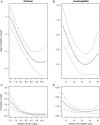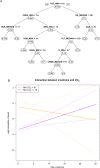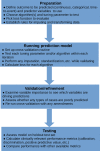Moving beyond regression techniques in cardiovascular risk prediction: applying machine learning to address analytic challenges
- PMID: 27436868
- PMCID: PMC5837244
- DOI: 10.1093/eurheartj/ehw302
Moving beyond regression techniques in cardiovascular risk prediction: applying machine learning to address analytic challenges
Abstract
Risk prediction plays an important role in clinical cardiology research. Traditionally, most risk models have been based on regression models. While useful and robust, these statistical methods are limited to using a small number of predictors which operate in the same way on everyone, and uniformly throughout their range. The purpose of this review is to illustrate the use of machine-learning methods for development of risk prediction models. Typically presented as black box approaches, most machine-learning methods are aimed at solving particular challenges that arise in data analysis that are not well addressed by typical regression approaches. To illustrate these challenges, as well as how different methods can address them, we consider trying to predicting mortality after diagnosis of acute myocardial infarction. We use data derived from our institution's electronic health record and abstract data on 13 regularly measured laboratory markers. We walk through different challenges that arise in modelling these data and then introduce different machine-learning approaches. Finally, we discuss general issues in the application of machine-learning methods including tuning parameters, loss functions, variable importance, and missing data. Overall, this review serves as an introduction for those working on risk modelling to approach the diffuse field of machine learning.
Keywords: Electronic health records; Personalized medicine; Precision medicine; Risk prediction.
© The Author 2016. Published by Oxford University Press on behalf of the European Society of Cardiology.
Figures




Similar articles
-
Data-driven modeling and prediction of blood glucose dynamics: Machine learning applications in type 1 diabetes.Artif Intell Med. 2019 Jul;98:109-134. doi: 10.1016/j.artmed.2019.07.007. Epub 2019 Jul 26. Artif Intell Med. 2019. PMID: 31383477 Review.
-
Bayesian Networks for Risk Prediction Using Real-World Data: A Tool for Precision Medicine.Value Health. 2019 Apr;22(4):439-445. doi: 10.1016/j.jval.2019.01.006. Epub 2019 Mar 15. Value Health. 2019. PMID: 30975395 Review.
-
A data-driven approach to predicting diabetes and cardiovascular disease with machine learning.BMC Med Inform Decis Mak. 2019 Nov 6;19(1):211. doi: 10.1186/s12911-019-0918-5. BMC Med Inform Decis Mak. 2019. PMID: 31694707 Free PMC article.
-
Rise of the machines? Machine learning approaches and mental health: opportunities and challenges.Br J Psychiatry. 2018 Sep;213(3):509-510. doi: 10.1192/bjp.2018.105. Br J Psychiatry. 2018. PMID: 30113285
-
Machine learning in cardiovascular risk assessment: Towards a precision medicine approach.Eur J Clin Invest. 2025 Apr;55 Suppl 1:e70017. doi: 10.1111/eci.70017. Eur J Clin Invest. 2025. PMID: 40191920 Review.
Cited by
-
Machine learning-based diagnostic prediction of minimal change disease: model development study.Sci Rep. 2024 Oct 8;14(1):23460. doi: 10.1038/s41598-024-73898-4. Sci Rep. 2024. PMID: 39379539 Free PMC article.
-
Prediction of pulmonary pressure after Glenn shunts by computed tomography-based machine learning models.Eur Radiol. 2020 Mar;30(3):1369-1377. doi: 10.1007/s00330-019-06502-3. Epub 2019 Nov 8. Eur Radiol. 2020. PMID: 31705256
-
Comparison Between Statistical Model and Machine Learning Methods for Predicting the Risk of Renal Function Decline Using Routine Clinical Data in Health Screening.Risk Manag Healthc Policy. 2022 Apr 26;15:817-826. doi: 10.2147/RMHP.S346856. eCollection 2022. Risk Manag Healthc Policy. 2022. PMID: 35502445 Free PMC article.
-
A machine learning approach for the prediction of pulmonary hypertension.PLoS One. 2019 Oct 25;14(10):e0224453. doi: 10.1371/journal.pone.0224453. eCollection 2019. PLoS One. 2019. PMID: 31652290 Free PMC article.
-
Electronic Medical Record-Based Machine Learning Approach to Predict the Risk of 30-Day Adverse Cardiac Events After Invasive Coronary Treatment: Machine Learning Model Development and Validation.JMIR Med Inform. 2022 May 11;10(5):e26801. doi: 10.2196/26801. JMIR Med Inform. 2022. PMID: 35544292 Free PMC article.
References
-
- Stone NJ, Robinson JG, Lichtenstein AH, Bairey Merz CN, Blum CB, Eckel RH, Goldberg AC, Gordon D, Levy D, Lloyd-Jones DM, McBride P, Schwartz JS, Shero ST, Smith SC, Watson K, Wilson PWF, American College of Cardiology/American Heart Association Task Force on Practice Guidelines. 2013 ACC/AHA guideline on the treatment of blood cholesterol to reduce atherosclerotic cardiovascular risk in adults: a report of the American College of Cardiology/American Heart Association Task Force on Practice Guidelines. J Am Coll Cardiol 2014;63(25 Pt B):2889–2934. - PubMed
-
- January CT, Wann LS, Alpert JS, Calkins H, Cigarroa JE, Cleveland JC, Conti JB, Ellinor PT, Ezekowitz MD, Field ME, Murray KT, Sacco RL, Stevenson WG, Tchou PJ, Tracy CM, Yancy CW, ACC/AHA Task Force Members. 2014 AHA/ACC/HRS guideline for the management of patients with atrial fibrillation: executive summary: a report of the American College of Cardiology/American Heart Association Task Force on practice guidelines and the Heart Rhythm Society. Circulation 2014;130:2071–2104. - PubMed
-
- Morrow DA, Antman EM, Charlesworth A, Cairns R, Murphy SA, de Lemos JA, Giugliano RP, McCabe CH, Braunwald E.. TIMI risk score for ST-elevation myocardial infarction: a convenient, bedside, clinical score for risk assessment at presentation: an intravenous nPA for treatment of infarcting myocardium early II trial substudy. Circulation 2000;102:2031–2037. - PubMed
-
- Conroy RM, Pyörälä K, Fitzgerald AP, Sans S, Menotti A, De Backer G, De Bacquer D, Ducimetière P, Jousilahti P, Keil U, Njølstad I, Oganov RG, Thomsen T, Tunstall-Pedoe H, Tverdal A, Wedel H, Whincup P, Wilhelmsen L, Graham IM, SCORE project group. Estimation of ten-year risk of fatal cardiovascular disease in Europe: the SCORE project. Eur Heart J 2003;24:987–1003. - PubMed
-
- Wilson PW, D'Agostino RB, Levy D, Belanger AM, Silbershatz H, Kannel WB. Prediction of coronary heart disease using risk factor categories. Circulation 1998;97:1837–1847. - PubMed
Publication types
MeSH terms
Grants and funding
LinkOut - more resources
Full Text Sources
Other Literature Sources
Medical

